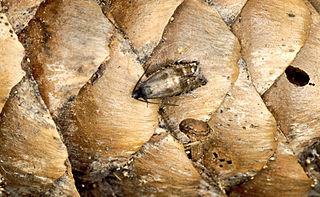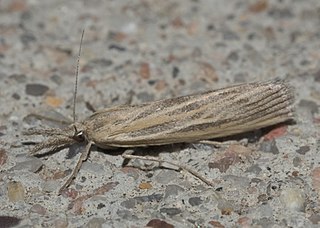| Fissicrambus intermedius | |
|---|---|
| Scientific classification | |
| Kingdom: | Animalia |
| Clade: | Euarthropoda |
| Class: | Insecta |
| Order: | Lepidoptera |
| Family: | Crambidae |
| Genus: | Fissicrambus |
| Species: | F. intermedius |
| Binomial name | |
| Fissicrambus intermedius (Kearfott, 1908) | |
| Synonyms | |
| |
Fissicrambus intermedius is a moth in the family Crambidae. It was described by Kearfott in 1908. [1] It is found in North America, where it has been recorded from Arizona, California and Texas. [2]

Moths comprise a group of insects related to butterflies, belonging to the order Lepidoptera. Most lepidopterans are moths, and there are thought to be approximately 160,000 species of moth, many of which have yet to be described. Most species of moth are nocturnal, but there are also crepuscular and diurnal species.

The Crambidae are the grass moth family of lepidopterans. They are variable in appearance, the nominal subfamily Crambinae taking up closely folded postures on grass stems where they are inconspicuous, while other subfamilies include brightly coloured and patterned insects which rest in wing-spread attitudes.
William D. Kearfott, was an American engineer and amateur entomologist. Kearfott was educated in primary schools in Richmond and Philadelphia and was connected with the Morton Poole Company and the International Navigation Company in his early career. Kearfott was also associated with the Worthington Steam Pump Company and was considered an authority on his branch of engineering.
The wingspan is 16–20 mm. The forewings are dark ochreous above a median white streak and light ochreous below it as well as on the outer third. The hindwings are white in males and whitish-grey in females. [3] Adults are on wing from March to May and from August to October. [4]

The wingspan of a bird or an airplane is the distance from one wingtip to the other wingtip. For example, the Boeing 777-200 has a wingspan of 60.93 metres, and a wandering albatross caught in 1965 had a wingspan of 3.63 metres, the official record for a living bird. The term wingspan, more technically extent, is also used for other winged animals such as pterosaurs, bats, insects, etc., and other fixed-wing aircraft such as ornithopters. In humans, the term wingspan also refers to the arm span, which is distance between the length from one end of an individual's arms to the other when raised parallel to the ground at shoulder height at a 90º angle. Former professional basketball player Manute Bol stands at 7 ft 7 in (2.31 m) and owns one of the largest wingspans at 8 ft 6 in (2.59 m).

